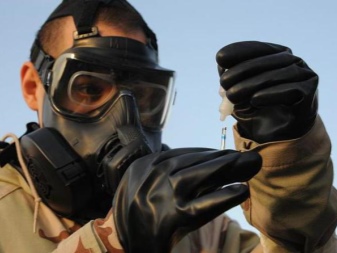Peculiarities
Let's start with the fact that these gloves are of two types, which are called so: KShchS type 1 gloves and KShchS type 2 gloves. Their main difference is the thickness of the protective layer. Acid-alkali-resistant gloves of the first type are twice as thick as those of the second (from 0.6 to 1.2 millimeters). This allows them to withstand exposure to solutions with concentration of acids and alkalis up to 70%. However, their high density constrains the movement of the hand, which is why they are only intended for rough work. Technical gloves are much more reliable than ordinary rubber gloves (household or medical). They provide an increased level of protection and are able to withstand higher physical activity. This is a necessary quality, because if the protective layer breaks through, then hazardous compounds can get on the human skin.
They are made from latex. In terms of its properties, this material is similar to rubber, but it is better suited just for personal protective equipment. Latex is more viscous, which gives a greater degree of comfort, and is also completely natural, which allows you to reduce the negative effects of prolonged contact with the skin to a minimum. The description tells us that the recommended temperature for using gloves is 10 to 35 degrees. When they go beyond these limits, they will, of course, still be usable, but their protective performance or level of convenience may be reduced.


Scope of application
Such gloves are used in various fields, a description of which you can find below.
Use of KShchS type I protective gloves.
- In aviation. For the process of assembling and connecting elements.
- In all branches of the chemical industry.
- In the processing of metals. Applying paints and varnishes to surfaces, making batteries, etc.
- In agriculture.
- At automotive and instrument-making enterprises. Work involves interaction with coloring pigments and electrolytes.


Type II acid and alkali resistant gloves are used in the following applications.
- In pharmacology. Manufacturing functions involve the creation of drugs, employees come into contact with chemical compounds that harm the skin deprived of protection.
- In the automotive industry. During work, there is a mandatory contact with oily liquids and some number of acids.
- In the chemical industry. Manufacturing and its mixed industries are the main structure where PPE is needed. Employees dealing with highly aggressive conditions must be fully equipped with overalls, and gloves are an obligatory part of the industrial kit.
- In agricultural production. This area of activity also includes work with the use of toxic chemicals, for example, the production of fertilizers, the manufacture of drugs aimed at controlling parasitic pests and the decontamination of technical installations.


Scope of application
Chemical resistant latex gloves are used today in a variety of applications:
- pharmaceuticals - used in the manufacture of medicines, in laboratories in contact with chemicals;
- automotive industry - work in this area involves contact with engine oils and fluids, which contain acidic compounds;
- chemical industry - when working in a production of this type, employees are equipped with a full protective kit, where gloves are part of a protective suit, without them, the presence of an employee at the workplace is unacceptable;
- agricultural work - even in this industry one has to deal with chemicals: when using insect and rodent control agents, at the time of disinfection of equipment and premises.


